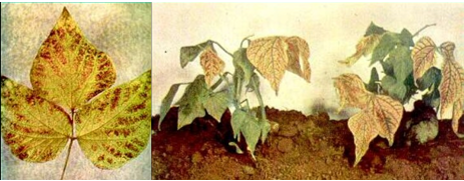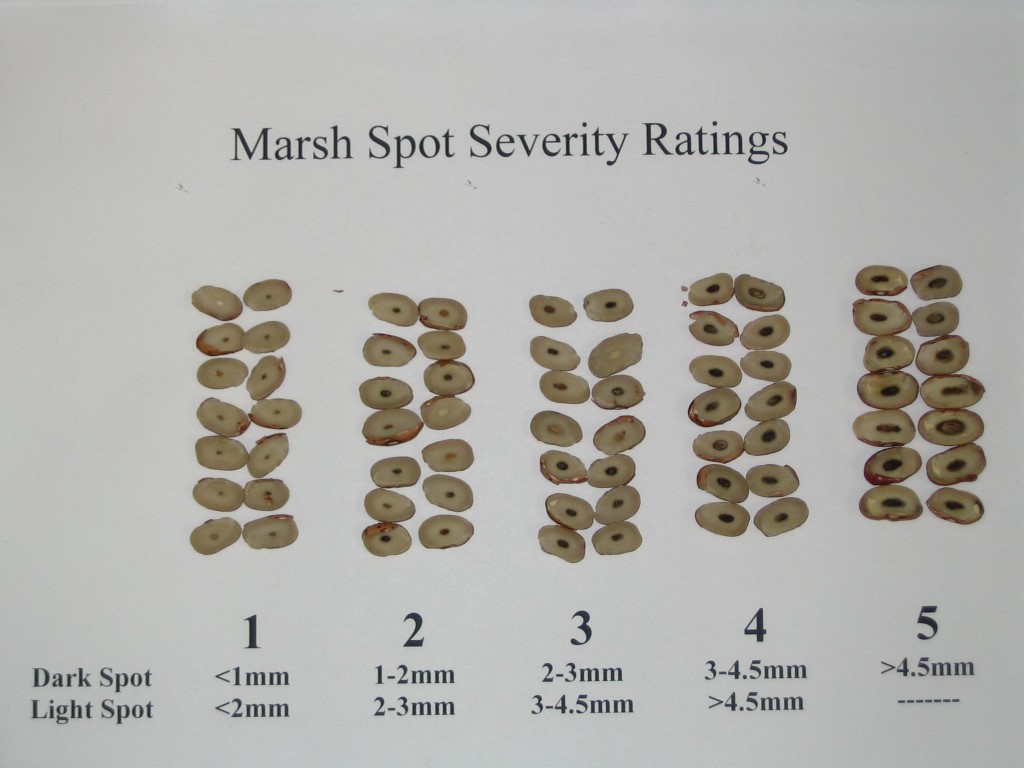This article was written by Mylene Corzo Lopez, University of Guelph
Summary
Marsh spot is due to imbalanced nutrient supply to crops, mainly associated with manganese (Mn) deficiencies in the pea and bean plants and is not caused by pathogens such as virus or bacteria. It is most often found in cranberry bean seed. Marsh spot is observed as brown discolorations on the flat inner surfaces of the cotyledons. Studies conducted by Gillard et al. since 2012 have indicated that the cells in the center of the cotyledon of beans with Marsh spot can turn a gray to black colour and can be noticed once the seed is split along the cotyledonary axis. This physiological disorder is also occasionally found in kidney beans and this non-pathogenic disease can cause serious economic losses for farmers and marketing issues for bean traders.
Marsh spot symptoms increase with a rise in the alkalinity of the soil. It has been found that in soils containing suitable levels of manganese crops may show symptoms related to manganese deficiency because this element is made unavailable through the interactions among different factors in the soil, including pH, soil composition and biological activity.
Manganese is a trace element that performs important functions in the plant. It plays a direct role in photosynthesis, and it accelerates germination and maturity while increasing the availability of phosphorus (P) and calcium (Ca).
Symptoms on seeds
In the seeds, symptoms are usually identified as a discoloured spot in the centre of each cotyledon, readily seen if the seed is split open after softening by soaking. There is generally a small black spot in the middle, with a brownish red discoloration around this and possibly further discoloration in the form of a dark halo. The size of the spot varies, it can be quite small, or large. However, the lesion never extends over the whole inner face of the cotyledon. Moreover, extensive cotyledon necrosis predisposes the seed to attack by secondary bacterial or fungal organisms which may aggravate the damage.

Photo credit: Color Pictures of Mineral Deficiencies in Beans
Foliar Symptoms
Depending on the degree of deficiency of this trace element, plants may or may not show visual foliar symptoms related to manganese deficiency. In general, symptoms start as an interveinal chlorotic area on the leaves, beginning at the leaf margins. Later this deficiency appears in patches. Sometimes, leaves are small with occasional brown necrotic areas and pods are poorly filled. When there is an acute deficiency, the growth of the plants can be normal until manganese in the seed is used up, and after that the internodes of the seedlings turn brown, the youngest leaves remain small and develop discoloured areas of collapsed tissue between the veins, while the oldest leaves take a mottled yellow appearance with the veins showing as a green network. Finally, plants undergo premature death before pod- setting.

Photo credit: Color Pictures of Mineral Deficiencies in Beans
Condition inducing manganese deficiency.
The conditions that encourage manganese deficiency in crops include high soil organic matter content, poor drainage, high water-table and high pH (alkalinity). These conditions typically exist wherever crops are manganese-deficient, and their combination can trigger an increased immobilization of manganese in the soil and intensify Marsh spot symptoms. By contrast, in strongly acidic soils, manganese may be present in toxic concentration, causing crop failures attributed to soil acidity.

Photo credit: Color Pictures of Mineral Deficiencies in Beans
Management
This disorder may be controlled by applying manganous sulphate in solution as a spray at flowering time, instead of directly applying the powder to the soil. In this case, the spray application at flowering allows the available manganese to be absorbed directly by the plant through the foliage. Two applications can be used if there is a rain following the first application. Treatment with manganese before flowering may be ineffective in preventing Marsh spot because this disorder is controlled by adequate amounts of manganese throughout the seed formation period.
References:
-Gillard, C. (2016). Agronomy and Pest Management Research Results for Dry Edible Beans. University of Guelph, Ridgetown Campus.
-Gillard, C. (2017). Agronomy and Pest Management Research Results for Dry Edible Beans. University of Guelph, Ridgetown Campus.
-Glasscock, H. H. and R.L. Wain. (1940). J. Agrie. Sei. 30:132-140.
-Piper, C. S. (1942). Marsh spot of peas: a manganese deficiency disease. Waite Agricultural Research Institute, University of Adelaide.
-Reynold, J. D. (1955). Marsh spot of peas: A review of present knowledge. J. Sci. Food Agric.
